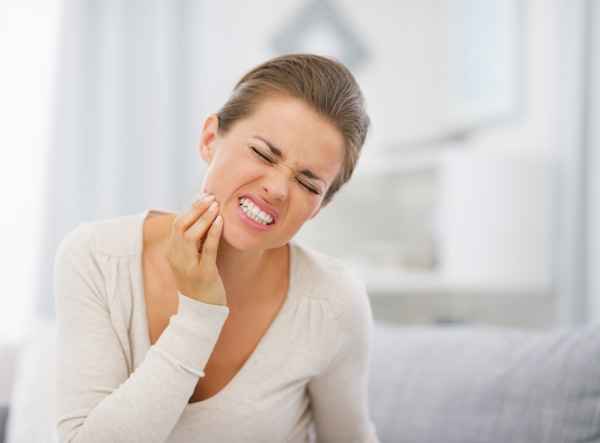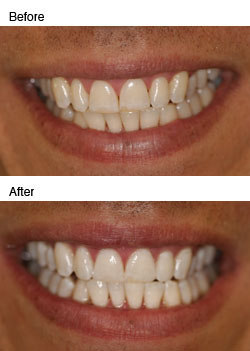The most common cause of sensitive teeth (or dentinal hypersensitivity as it's called by dentists) is the exposure of the sensitive part of the tooth called the œdentin. The dentin is made up of thousands of microscopic passageways that lead to the tooth's nerve center. These passageways, known as tubules, are normally covered and protected by the tooth's enamel and the surrounding gums. But when the dentin is exposed, and your teeth come in contact with something hot, cold or sweet, the tubules carry the sensation directly to the tooth's nerves and cause pain. 
Potential Causes of Dental Exposure and Sensitivity
-
Gingival recession due to periodontal infection
-
Trauma from improper brush techniques
-
Use of abrasive dentifrices
-
The anatomy of the cementoenamel junction
-
Restorative procedures
-
Oral surgery
-
Bruxism and clenching
-
Consumption of highly acidic foods and drinks, such as citric fruits and some carbonated beverages
-
Xerostomla, either through side effects caused by pharmaceutical agents, aging, or radiation therapy
Tooth whitening is a procedure that lightens teeth and helps to remove stains and discoloration. Whitening is among the most popular cosmetic dental procedures because it can significantly improve the appearance of your teeth at much less cost and inconvenience than other techniques. The majority of dentists perform tooth whitening. Every day, a thin coating forms on your teeth and it picks up stains. Also, the outer layer of each tooth, called the enamel, contains pores that can hold stains. Whitening is not a one-time solution. It will need to be repeated periodically if you want to maintain the brighter color. 
The most common reasons for yellowing or stained teeth are aging, tobacco, tea and coffee, which can stain the surface of the teeth. It is also possible to have stains that are inside the tooth. These are called intrinsic stains. For example, intrinsic stains can be caused by exposure to too much fluoride as a child while teeth are developing. Other causes include tetracycline antibiotics taken during the second half of pregnancy or given to children 8 years old or younger when the teeth are still developing. Tooth whitening is most effective on surface stains caused by age, foods or drinks.
Risks
Whitening is unlikely to cause serious side effects, although some people;'s teeth may become more sensitive temporarily. There may be mild gum irritation as well. Whitening procedures should not be done while a woman is pregnant because the effect of the whitening materials on the development of the fetus is not known. Since the procedure is cosmetic and option, it should be postponed until after delivery.
Many experts recommend breast-feeding over bottle-feeding for the overall health of your child. However, breast-feeding can lead to Early Childhood Cavities in the same way that bottle-feeding can. 
To prevent Early Childhood Cavities: Avoid letting baby walk around with a bottle.
Avoid overnight feeding.
The Indian Dental Association recommends that you encourage your child to drink from a cup by his or her first birthday.
Is it Okay if My Child Sucks his or her Thumb? Thumbsucking is normal for infants; most stop on their own by age 2.
If your child sucks his or her thumb beyond age 2, try to discourage it by age 4.
Thumbsucking beyond age 4 can lead to crooked, crowded teeth and/or bite problems.
Is it Okay For My Baby to Use a Pacifier? Yes, but don't dip it in sugar, honey, or sweetened liquid. In addition:
Try to have your child give up the pacifier by age 2.
Keep in mind that while a pacifier and thumbsucking create no health difference for the child, a pacifier may be a better choice because it can be easier to wean your child from a pacifier than from thumbsucking.
What is the Best Way to Brush a Toddler's Teeth?
Use a small, soft-bristled brush. Use a circular or wiggling motion on all tooth surfaces, especially where the tooth meets the gumline. Once your toddler is able to spit out, use a pea-sized amount of fluoride toothpaste on the brush. Families should ask their dentist to demonstrate proper toothbrushing during the child's dental visit.
Can I Transmit Harmful Bacteria That May Affect My Baby's Teeth?
Yes. Cavity-causing germs can be transmitted through contact – like when baby puts hands in your mouth, and then in his or her own mouth. That's why it's so important to keep your own teeth and gums healthy.
In addition, research has shown that since a pregnant woman shares blood with her unborn baby, any infection of the mouth – such as a cavity or gum (periodontal) disease – can affect the baby.
When should I Start Using Fluoride Toothpaste for My Child?
When your child is able to spit. Fluoride is safe and necessary to keep teeth strong, but only at appropriate levels.

